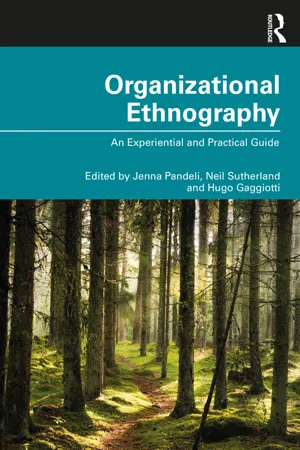
Organizational Ethnography
An Experiential and Practical Guide
- 264 pages
- English
- ePUB (mobile friendly)
- Available on iOS & Android
Organizational Ethnography
An Experiential and Practical Guide
About this book
This textbook explores practices, first-hand experiences and emerging ideas within organizational ethnography, providing a toolkit that prepares ethnographers for the uncertainties and realities of fieldworking.
Students faced with the complexities of qualitative observational techniques and considerations, such as the scope of the research, the personal and professional intertwined life of the qualitative research or the decision of when to leave the field, will find the book an extremely useful, practical guide. A range of experiences from a variety of academics at different stages of their career, to highlight the differences in practices, approaches and encounters, are presented. The themes of the individual chapters cover three main areas: aspects to consider and reflect on before undertaking an ethnography, the process and experiences of conducting ethnographic work and considerations for after the fieldwork. Particular attention is given to appreciating the complexity and practicalities of ethnographic work, providing a more experience-driven text, and understanding perspectives from a range of different approaches to organizational ethnography.
This book should be a recommended text for advanced undergraduate and postgraduate students studying research methods within Business and Management. It is particularly important for all students and academics undertaking qualitative research, especially ethnography.
Frequently asked questions
- Essential is ideal for learners and professionals who enjoy exploring a wide range of subjects. Access the Essential Library with 800,000+ trusted titles and best-sellers across business, personal growth, and the humanities. Includes unlimited reading time and Standard Read Aloud voice.
- Complete: Perfect for advanced learners and researchers needing full, unrestricted access. Unlock 1.4M+ books across hundreds of subjects, including academic and specialized titles. The Complete Plan also includes advanced features like Premium Read Aloud and Research Assistant.
Please note we cannot support devices running on iOS 13 and Android 7 or earlier. Learn more about using the app.
Information
1Outlining a practical, emotional and reflexive approach to organizational ethnography
- An honest look into what it is like to do ethnographic work, written from a range of colleagues, from early career researchers to seasoned ethnographers
- Informal, conversational and friendly writing that guides you through the internal issues that contemporary ethnographers have contended with
- An understanding into the unfolding, messy and chaotic ethnographic process, rather than just the sanitized outcome of the research project
- Advice on how to approach tricky situations – from covert research to difficult conversations to keeping level-headed and analytical in the heat of the field
- Reassurance that as long as you are paying due consideration to your approach, you are probably not doing it “wrong”, and that a plurality of appropriate approaches exist
Defining ethnography
It differs from other approaches to research in that it requires immersion and translation. Ethnography is not a quick dip into a research site using surveys and interviews, but an extended period time in which the ethnographer immerses herself in the community she is studying: interacting with community members, observing, building relationships, and participating in community life.(Cunliffe, 2010: 230)
The primary and most complex feature of ethnographic writing is to translate ethnographic material (field notes and supplementary data) into an ethnographic text. In order to achieve this translation, ethnographers usually carry out a form of indexing. First, ethnographers need to organize their material into a coherent form. This might involve going through their field diaries of observations to make sure they make senses, transcribing interviews (if they have carried out interviews) and organizing any documents they have collected so that they make sense (that is, the ethnographer understands where they came from and what organizational role they played).(Neyland, 2008: 126)
Discussion points
What can I do with this advice in this book? How will it help me prepare for an ethnographic project?
Table of contents
- Cover
- Endorsements Page
- Half-Title Page
- Title Page
- Copyright Page
- Contents
- Contributors
- 1 Outlining a practical, emotional and reflexive approach to organizational ethnography
- Part I Emotions, ethnography, and fieldwork
- Part II Ethnography in the field
- Part III Beyond the field
- Index